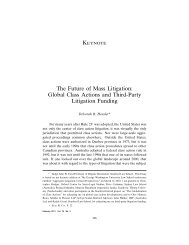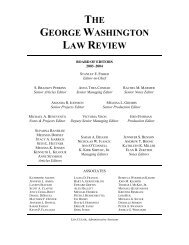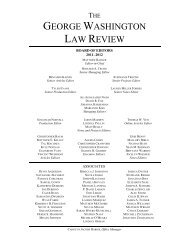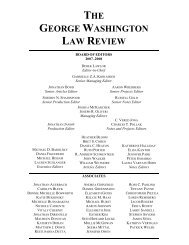View PDF - The George Washington Law Review
View PDF - The George Washington Law Review
View PDF - The George Washington Law Review
Create successful ePaper yourself
Turn your PDF publications into a flip-book with our unique Google optimized e-Paper software.
874 <strong>The</strong> <strong>George</strong> <strong>Washington</strong> <strong>Law</strong> <strong>Review</strong> [Vol. 78:870<br />
Although it is discussed in detail later in the Note, 18 it is important<br />
to mention at the outset that the proposed rule does not strictly<br />
adhere to the cost-basis economic philosophy. To put it simply, a<br />
property owner’s cost basis is only protected to the extent that it does<br />
not exceed the property’s fair market value at the time of purchase.<br />
This is because a regulation is not proximately responsible for the gap<br />
between the property’s value and the purchase price if the purchase<br />
price is in excess of fair market value. <strong>The</strong> rule does not protect unreasonable<br />
investments.<br />
Additionally, the proposed rule does not offer complete protection<br />
to investments, even those that are reasonably made. A property<br />
owner’s cost basis, assuming it does not exceed fair market value at<br />
the time of purchase, is protected from the effects of regulatory constraint.<br />
If, however, the decline in property value is proximately<br />
caused by something other than government regulation (e.g., economic<br />
recession), there is no taking.<br />
<strong>The</strong> proposed method of analysis will provide for a regulatory<br />
takings test that is more predictable than that of Penn Central. Most<br />
important is that the increased predictability and clarity does not<br />
come at the expense of property owners’ protections. Unlike the existing<br />
law of regulatory takings, the proposed test provides property<br />
owners with the protection that they not only deserve, but are also<br />
constitutionally guaranteed.<br />
Part I describes and assesses the current state of regulatory takings<br />
law. Understanding the evolution of regulatory takings analysis<br />
to date is vital to understanding the rationale for imposing a new doctrine.<br />
Part II analyzes the Lingle case and explains that its holding<br />
may have drastic implications for the Penn Central balancing test. It is<br />
argued that Lingle may be understood as precipitating a major shift in<br />
the Court’s judicial philosophy. Part III considers two routes forward<br />
that the Court may take in applying regulatory takings analysis after<br />
Lingle, but ultimately concludes that both options are inadequate.<br />
Part IV then proposes that the Court embrace an alternative method<br />
of analyzing regulatory takings claims. This Part provides an in-depth<br />
examination of the proposed per se rule, which is rooted in a costbasis<br />
economic theory. Part V considers various theories as to why<br />
compensation should be provided for government takings. Because<br />
this Note proposes a new takings analysis, it is necessary to address<br />
the policies behind the constitutional award of just compensation and<br />
18 See infra Part IV.D.









